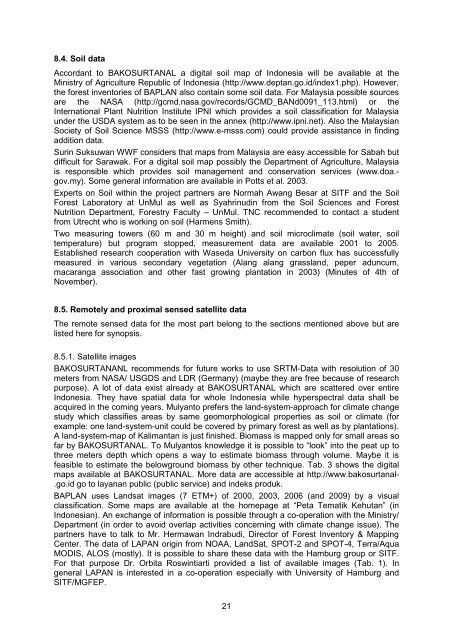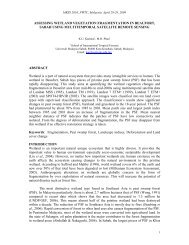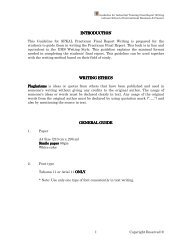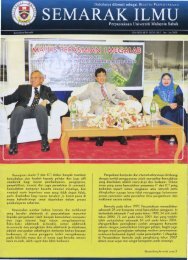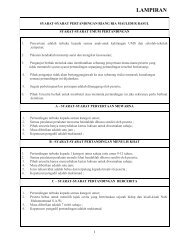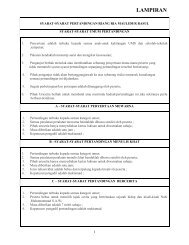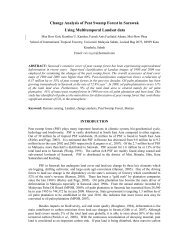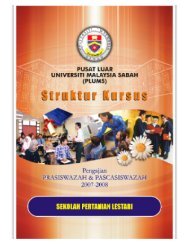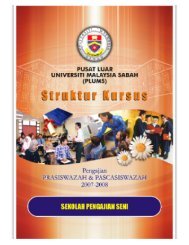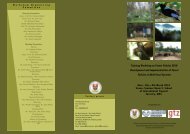Report for the German Agency for Technical Cooperation (GTZ) - UMS
Report for the German Agency for Technical Cooperation (GTZ) - UMS
Report for the German Agency for Technical Cooperation (GTZ) - UMS
You also want an ePaper? Increase the reach of your titles
YUMPU automatically turns print PDFs into web optimized ePapers that Google loves.
8.4. Soil data<br />
Accordant to BAKOSURTANAL a digital soil map of Indonesia will be available at <strong>the</strong><br />
Ministry of Agriculture Republic of Indonesia (http://www.deptan.go.id/index1.php). However,<br />
<strong>the</strong> <strong>for</strong>est inventories of BAPLAN also contain some soil data. For Malaysia possible sources<br />
are <strong>the</strong> NASA (http://gcmd.nasa.gov/records/GCMD_BANd0091_113.html) or <strong>the</strong><br />
International Plant Nutrition Institute IPNI which provides a soil classification <strong>for</strong> Malaysia<br />
under <strong>the</strong> USDA system as to be seen in <strong>the</strong> annex (http://www.ipni.net). Also <strong>the</strong> Malaysian<br />
Society of Soil Science MSSS (http://www.e-msss.com) could provide assistance in finding<br />
addition data.<br />
Surin Suksuwan WWF considers that maps from Malaysia are easy accessible <strong>for</strong> Sabah but<br />
difficult <strong>for</strong> Sarawak. For a digital soil map possibly <strong>the</strong> Department of Agriculture, Malaysia<br />
is responsible which provides soil management and conservation services (www.doa.gov.my).<br />
Some general in<strong>for</strong>mation are available in Potts et al. 2003.<br />
Experts on Soil within <strong>the</strong> project partners are Normah Awang Besar at SITF and <strong>the</strong> Soil<br />
Forest Laboratory at UnMul as well as Syahrinudin from <strong>the</strong> Soil Sciences and Forest<br />
Nutrition Department, Forestry Faculty – UnMul. TNC recommended to contact a student<br />
from Utrecht who is working on soil (Harmens Smith).<br />
Two measuring towers (60 m and 30 m height) and soil microclimate (soil water, soil<br />
temperature) but program stopped, measurement data are available 2001 to 2005.<br />
Established research cooperation with Waseda University on carbon flux has successfully<br />
measured in various secondary vegetation (Alang alang grassland, peper aduncum,<br />
macaranga association and o<strong>the</strong>r fast growing plantation in 2003) (Minutes of 4th of<br />
November).<br />
8.5. Remotely and proximal sensed satellite data<br />
The remote sensed data <strong>for</strong> <strong>the</strong> most part belong to <strong>the</strong> sections mentioned above but are<br />
listed here <strong>for</strong> synopsis.<br />
8.5.1. Satellite images<br />
BAKOSURTANANL recommends <strong>for</strong> future works to use SRTM-Data with resolution of 30<br />
meters from NASA/ USGDS and LDR (<strong>German</strong>y) (maybe <strong>the</strong>y are free because of research<br />
purpose). A lot of data exist already at BAKOSURTANAL which are scattered over entire<br />
Indonesia. They have spatial data <strong>for</strong> whole Indonesia while hyperspectral data shall be<br />
acquired in <strong>the</strong> coming years. Mulyanto prefers <strong>the</strong> land-system-approach <strong>for</strong> climate change<br />
study which classifies areas by same geomorphological properties as soil or climate (<strong>for</strong><br />
example: one land-system-unit could be covered by primary <strong>for</strong>est as well as by plantations).<br />
A land-system-map of Kalimantan is just finished. Biomass is mapped only <strong>for</strong> small areas so<br />
far by BAKOSURTANAL. To Mulyantos knowledge it is possible to “look” into <strong>the</strong> peat up to<br />
three meters depth which opens a way to estimate biomass through volume. Maybe it is<br />
feasible to estimate <strong>the</strong> belowground biomass by o<strong>the</strong>r technique. Tab. 3 shows <strong>the</strong> digital<br />
maps available at BAKOSURTANAL. More data are accessible at http://www.bakosurtanal-<br />
.go.id go to layanan public (public service) and indeks produk.<br />
BAPLAN uses Landsat images (7 ETM+) of 2000, 2003, 2006 (and 2009) by a visual<br />
classification. Some maps are available at <strong>the</strong> homepage at “Peta Tematik Kehutan” (in<br />
Indonesian). An exchange of in<strong>for</strong>mation is possible through a co-operation with <strong>the</strong> Ministry/<br />
Department (in order to avoid overlap activities concerning with climate change issue). The<br />
partners have to talk to Mr. Hermawan Indrabudi, Director of Forest Inventory & Mapping<br />
Center. The data of LAPAN origin from NOAA, LandSat, SPOT-2 and SPOT-4, Terra/Aqua<br />
MODIS, ALOS (mostly). It is possible to share <strong>the</strong>se data with <strong>the</strong> Hamburg group or SITF.<br />
For that purpose Dr. Orbita Roswintiarti provided a list of available images (Tab. 1). In<br />
general LAPAN is interested in a co-operation especially with University of Hamburg and<br />
SITF/MGFEP.<br />
21


